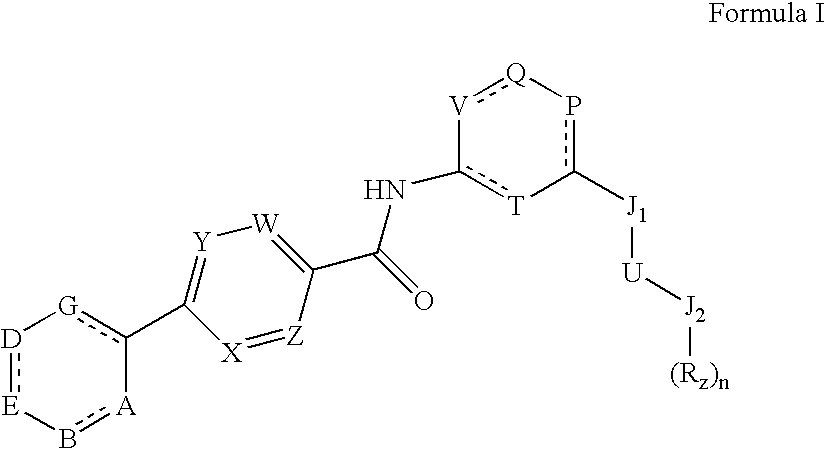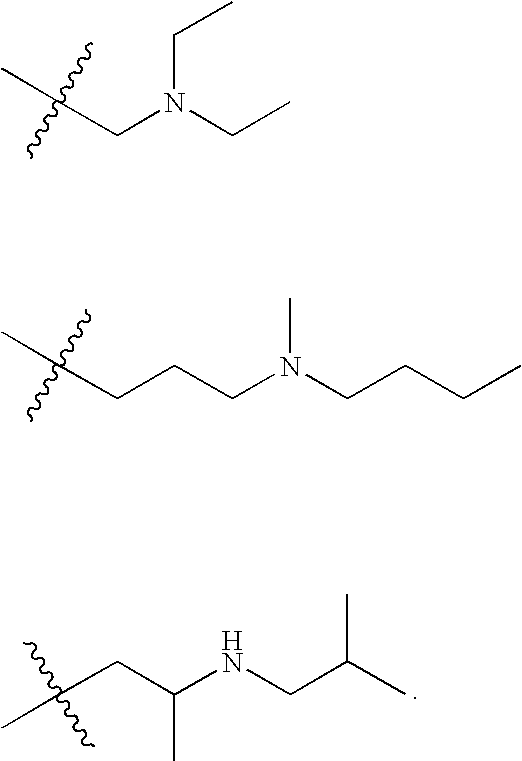Heteroalkyl-substituted biphenyl-4-carboxylic acid arylamide analogues
a technology of arylamide and aryl amine, which is applied in the field of heteroalkyl-substituted biphenyl-4-carboxylic acid analogues, can solve the problems of more debilitating, acute or chronic pain, and damage to the nervous system, and achieves the effects of reducing the calcium conductance of a cellular capsaicin receptor, promoting weight loss, and inhibiting the binding of vanilloid lig
- Summary
- Abstract
- Description
- Claims
- Application Information
AI Technical Summary
Benefits of technology
Problems solved by technology
Method used
Image
Examples
example 1
Preparation of Representative Heteroalkyl-Substituted Biphenyl-4-Carboxylic Acid Arylamide Analogues
[0182] This Example illustrates the synthesis of N-{4-tert-butyl-3-[2-(2,6-dimethyl-morpholin-4-yl)-ethoxy]-phenyl}-4-(3-trifluoromethyl-pyridin-2-yl)-benzamide (cis).
1. tert-Butyl-[2-(2-tert-butyl-5-nito-phenoxy)-ethoxy]-dimethyl-silane
[0183]
[0184] To a solution of diisopropyl azodicarboxylate (2.02 g, 10 mmol) and triphenyl phosphine (2.63 g, 10 mmol) in THF (100 ml) at 0° C., add 2-tert-butyl-5-nitrophenol (1.95 g, 10 mmol) and then tert-(butyldimethylsilyloxy)ethanol (1.76 g, 10 mmol). Allow the reaction mixture to return to room temperature and stir overnight. Partition the residue between ethyl acetate and 1M sodium hydroxide and extract with further ethyl acetate. Dry the combined extracts (MgSO4) and concentrate under reduced pressure. Purify the residue by flash chromatography on silica gel (95% hexane / 5% ether) to give the title compound.
2. 4-tert-Butyl-3-[2-(tert-butyl...
example 2
[0195] Additional Representative Heteroalkyl-Substituted Biphenyl-4-Carboxylic Acid Arylamide Analogues
[0196] Using routine modifications, the starting materials may be varied and additional steps employed to produce other compounds provided herein. Compounds listed in Table I are prepared using such methods. In the column labeled “IC50” a * indicates that the IC50 determined as described in Example 5 is 1 micromolar or less (i.e., the concentration of such compounds that is required to provide a 50% decrease in the fluorescence response of cells exposed to one IC50 of capsaicin is 1 micromolar or less). Mass Spectroscopy data in the column labeled “MS” is Electrospray MS, obtained in positive ion mode with a 15V or 30V cone voltage, using a Micromass Time-of-Flight LCT, equipped with a Waters 600 pump, Waters 996 photodiode array detector, Gilson 215 autosampler, and a Gilson 841 microinjector. MassLynx (Advanced Chemistry Development, Inc; Toronto, Canada) version 4.0 software is...
example 3
[0198] VR1-Transfected Cells and Membrane Preparations
[0199] This Example illustrates the preparation of VR1-transfected cells and membrane preparations for use in binding assays (Example 4) and functional assays (Example 5).
[0200] A cDNA encoding full length human capsaicin receptor (SEQ ID NO:1, 2 or 3 of U.S. Pat. No. 6,482,611) is subcloned in the plasmid pBK-CMV (Stratagene, La Jolla, Calif.) for recombinant expression in mammalian cells.
[0201] Human embryonic kidney (HEK293) cells are transfected with the pBK-CMV expression construct encoding the full length human capsaicin receptor using standard methods. The transfected cells are selected for two weeks in media containing G418 (400 μg / ml) to obtain a pool of stably transfected cells. Independent clones are isolated from this pool by limiting dilution to obtain clonal stable cell lines for use in subsequent experiments.
[0202] For radioligand binding experiments, cells are seeded in T175 cell culture flasks in media withou...
PUM
| Property | Measurement | Unit |
|---|---|---|
| Molar density | aaaaa | aaaaa |
| Fraction | aaaaa | aaaaa |
| Fraction | aaaaa | aaaaa |
Abstract
Description
Claims
Application Information
 Login to View More
Login to View More - R&D
- Intellectual Property
- Life Sciences
- Materials
- Tech Scout
- Unparalleled Data Quality
- Higher Quality Content
- 60% Fewer Hallucinations
Browse by: Latest US Patents, China's latest patents, Technical Efficacy Thesaurus, Application Domain, Technology Topic, Popular Technical Reports.
© 2025 PatSnap. All rights reserved.Legal|Privacy policy|Modern Slavery Act Transparency Statement|Sitemap|About US| Contact US: help@patsnap.com



